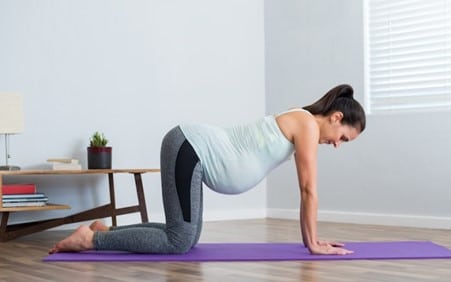Many expectant moms are unaware that pelvic floor exercises can already be of great benefit during pregnancy as they can facilitate childbirth and postpartum recovery. But how can you relax your pelvic floor if you don’t even know where it is exactly? And how can you rebuild it if you haven’t yet developed a feel for it ? Pregnancy is the ideal time to get a little more acquainted with your pelvic area.
The miracle of the pelvic floor
The pelvic floor is an exception among muscles because it has to master very contradictory tasks; it must be stable, yet elastic and flexible at the same time. During pregnancy and during childbirth both sides demand absolute maximum performance. The pelvic floor holds, closes and carries all our organs. In pregnancy it also carries the baby and its surrounding environment, which can easily add up to an extra six kilograms on the scale. Ultimately, after many difficult and exhausting months of holding on, from one moment to the next the pelvic floor has to do the complete opposite and simply let go, loosen and open up like never before.
1. Become aware of its location
To be able to perceive the pelvic floor, it’s pretty helpful to know where it is first.
Roughly speaking, it lies between four bony vertices. The pubic bone sits in the front, the tailbone in the back, and the sitting bones are found to its left and right. The sitting bones can be felt by sitting on your hands and rocking back and forth with the pelvis. The pubic bone can be easily felt in front – you’ll find it about a hand’s length below your belly button. If you let your hand slide down your spine, you’ll find your tailbone at the very end of it, between the buttocks. You can now playfully get a bit more acquainted with these four points.
An exercise for the conscious perception of the pelvic floor:
- While sitting, gently pull your two sitting bones towards each other and let them glide apart again. Relax your gluteal muscles throughout this exercise.
- Get into an all-fours pose or into downward dog and imagine wide space between the two sitting bones. Imagine that they are grinning in these positions.
- Pull your tailbone towards the pubis and think of as much space between these two points as possible.
- While still on all fours or downward dog, imagine a brush attached to your tailbone, with which you write your baby’s name on the wall behind you. Move your pelvis to spell out the name and make sure to keep it relaxed during this – try only to move the tailbone. A fun mental image is that of an excited puppy who is glad to see its owner again and happily wagging its tail.
2. Be on the move
Keeping your body in motion during your pregnancy helps keep your pelvic floor flexible. Take the stairs from time to time, walk a lot, try out yoga or get moving in the water. If you want to keep your pelvic floor moving in a more targeted manner, try the following two exercises:
- Imagine there is a sponge in your pelvis with a bit of water. You gently squeeze the water from this sponge with your exhalation. As you inhale imagine the sponge getting completely soaked with water, taking it all up and expanding throughout the pelvic area. The focus here is on letting go, the width created in the pelvis and between the four bony vertices.
- Sufi circles: get comfortable in a cross-legged pose, tree pose or whatever is comfortable for you and then begin to move your upper body in circles. Do not do this mechanically, but just to the degree and speed that it feels good for you. This exercise not only increases circulation in the pelvic floor but also moves the connective tissue in your back. The exercise is very helpful during labor. Birth is movement!

3. Give it a break
The further you progress in your pregnancy, the softer your tissue becomes. Your pelvis is preparing to let your baby through. The network of muscles, ligaments and connective tissue loosens and changes the entire pelvic position. This is often accompanied by aches and pains in the back or pelvis. Try to keep reminding yourself to raise your pelvis a bit. Imagine that you are raising your baby up to sit under your heart. This prevents you from falling completely into a hollow back position.
Softer tissue and additional weight is an unfavorable combination. With the following exercises you can offer your pelvic floor some relief in between:
- The supported shoulder bridge: Lay down on your back, bend your knees and place your feet down on the floor and put a big pillow under your buttocks. In addition, to relieve your legs, you can stretch one leg after the other slowly upwards. If you practice this close to a wall you can now rest your legs against the wall – this makes the exercise even more relaxing. This is my personal queen of all relaxation exercises.
- The knee-elbow position: This is a cozy version of the 4-foot stand where you rest on your forearms instead of your hands; putting a pillow under your upper body makes it even more comfortable.

4. Get to know the pelvic floor’s best buddy
There is a direct connection between your jaw and your pelvic floor. If the jaw is tight, so is the pelvic floor. On the other hand, if you open your mouth and relax the jaw, your pelvic floor can open more easily. For this reason, jaw relaxation is often practiced in pregnancy yoga and birth preparation courses. I recall very well that during my first pregnancy yoga class “Maaaaa” rang through the whole room, and then later while practicing at home it rang through my living room. In the end, it turned into “Baaaaby ouuuut” and was also screamed rather than sung, but it still worked. The main things to focus on are that the mouth is open, the jaw loose and the sounds that come out are rather deep.
You can try the “donkey exercise”: first draw your attention to the pelvic floor area, so that you can perceive any changes and then say “eee aww“ just like a donkey. The high, short “eee” tightens the pelvic floor slightly and at the deep, long “aww” it relaxes again. Exciting, right?
5. Protect the pelvic floor from overload
Pregnancy and childbirth are a top athletic performance for your pelvic floor. Therefore, I have a few additional tips to help you protect your pelvic floor.
- Always be aware of the pelvic floor when getting up, sitting down and lifting.
- When sneezing and coughing, turn your head to the side and stand up, reducing your abdominal pressure. Also consciously raise the pelvic floor up here.
- Take care after giving birth and enjoy the (early) puerperium in peace and lie down a lot, not only your pelvic floor will thank you for this!




